Sep 1, 2020 | review, shows
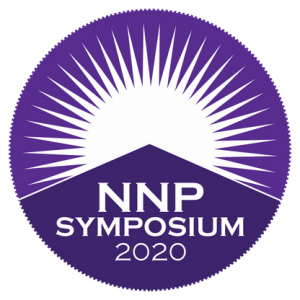 This past weekend, the Newman Numismatic Portal (NNP) sponsored the NNP Symposium. For three days, NNP used Zoom to facilitate 38 sessions about different aspects of numismatics. The topics covered everything from U.S. and foreign numismatics to discussions about the industry. The Numismatic Bibliomania Society held its Annual Meeting via Zoom, and Matt Dinger & Mike Nottelmann did a live version of The Coin Show. After listening to them for a while, I now see what they look like — I do not know if that is a good or bad thing.
This past weekend, the Newman Numismatic Portal (NNP) sponsored the NNP Symposium. For three days, NNP used Zoom to facilitate 38 sessions about different aspects of numismatics. The topics covered everything from U.S. and foreign numismatics to discussions about the industry. The Numismatic Bibliomania Society held its Annual Meeting via Zoom, and Matt Dinger & Mike Nottelmann did a live version of The Coin Show. After listening to them for a while, I now see what they look like — I do not know if that is a good or bad thing.
I was able to attend several of the sessions and deliver one of my own. Every session I attended was interesting and informative. The only complaint I had was that I could not attend every session. However, the NNP recorded each session and will be making them available online.
If you wanted to attend the symposium, you had to register to receive the Zoom credentials. There was no cost to register and no restrictions on the device you used. I attended the session before mine, presented by Doug Mudd, using my iPad. Since he went a little long, I was able to log into my session on my computer while watching the end of Doug’s on my iPad.
The entire numismatic community must commend the NNP and Lianna Spurrier, who coordinated the online event. Spurrier did the call for speakers, training sessions with the speakers, and probably a lot more behind the scenes we did not see.
As a member of the Numismatic Literary Guild, if there is an award for excellence in facilitating education, please allow me to nominate Spurrier for the award.
The NNP Symposium came due to an unusual set of circumstances that has seen the ANA’s Summer Seminar and every major coin show canceled. The NNP hit a homerun with its effort. The symposium was such a success that I hope the NNP makes this an annual event.
Mar 28, 2020 | review, technology

(yes, I borrowed their logo!)
Currently, there are three numismatic-related podcasts. Today’s review will only look at the newest entry, the Coin World Podcast.
The Coin World Podcast is one-year old. It started on March 28, 2019, and features hosts Jeff Starck and Chris Bulfinch, both writers for Coin World. After one-year, Jeff and Chris have hit on a rhythm that makes it worth listening.
If you binge listen from the beginning, you will find that it takes Jeff and Chris a while to fix a number of their technical issues. As a listener of those early shows, I can tell you that the sound quality was not right and sometimes was grating. It took almost two months for them to work out those issues.
Even with the lousy sound quality, it is worth going back and listening, especially for the interviews. After the banter at the beginning, each episode features a conversation with someone in the numismatic industry.
Doing a “live” interview, as opposed to an interview for print, is that a broadcast interview has to flow in a way that makes sense. Aside from being able to flow, the interviewer has to anticipate what the listener wants to hear. They ask compelling questions and add logical followup. It makes for a great listen.
As with a lot of podcasts, Jeff and Chris open with the news. While they do report the news, they do let some of their opinions show through. The way they add their opinion is not overt but enough to get their point across in a way that does not alienate a listener who might disagree.
A recent feature is a discussion of this period in numismatic history. Jeff and Chris would reference something that happened and read a contemporary account. They will also read letters that appeared in Coin World from years ago to prove the axiom, “the more things change, the more they stay the same.”
Combining history with contemporary accounts gives the feature a more exciting feel than just reciting facts. They should do this more with other discussions, especially with the library they have access to at Coin World.
After a year together, Jeff and Chris have developed a pleasant on-air rapport and a rhythm that makes the podcast worth the time to listen. However, whenever listening to the podcast, it feels as if something is missing before the interview. I know the P.T. Barnum once said, “Always leave them wanting more.” But there should be something else to add that one extra punch.
Having been a listener since Episode 1, the improvements have made a difference, and the interviews are enough to keep listeners coming back for more. I grade the podcast and MS-65, noting that there is a little room to add that one thing that can give it a grade boost.
Congratulations to Jeff Stark and Chris Bullfinch for making it to the first anniversary of the Coin World Podcast!
Sep 24, 2019 | books, review
During the unpacking of an estate, I came across a book with the title Coin of the Canonical Realm. It is a short, 58 pages, paperback book that has an intriguing cover. As a coin collector, I started to thumb through the book to get a sense of its purpose. Since it was not apparent, I had to wait until later.
After cleaning off my desk, I found the book and decided to read the Introduction to understand the book’s purpose. According to the introduction, its purpose is to “21st century sense of all the 19th century mentions of money in the Sherlock Holmes stories.”
Sherlock Holmes was a fictional detective created by Arthur Conan Doyle. Doyle created Holmes as a “consulting detective” so that the character can appear in varying environments. Doyle was one of the first authors to create a crime-fighting character that includes all of the tools that we take advantage of today. Someone suggested that Mission: Impossible is a modern extension of the Sherlock Holmes stories.
Most of Doyle’s stories are written from the perspective of John H. Watson, M.D. as Holmes’ biographer. Watson is a friend and part-time roommate who accompanies Holmes on his investigations. Watson can be annoyed with Holmes on some of his actions while being intrigued by his actions.
During his life, Doyle wrote 56 short stories and four novels about Sherlock Holmes. The short stories are compiled in five books which I have read three of them. All of the Sherlock Holmes stories are highly recommended.
The Sherlock Holmes stories endured long after Doyle’s passing in 1930. Aside from the movies and other new media recreations, there are societies dedicated to studying the intricacies of Holmes, the crimes, and other characters Doyle included. One of those organizations is The John H. Watson Society.
The John H. Watson Society, founded in 2013, is described as an organization that will study Dr. Watson as a unique individual and how his character enhances the Doyle classics. Watson, whose background is revealed throughout the stories, is a renown physician with a heroic war record and trust by a community is leery of the medial arts.
The book, written by Nickolas Utechin whose biography describes himself as having a long history with studying Sherlock Holmes, is the first monograph published by the John H. Watson Society.
Starting from Chapter 1, Utechin copies one or two-line passages from Doyle’s writings that reference money then explains them in the context of the 21st-century. He first describes the old British monetary system where there were 240 pence to a pound including the varying minor coins that were in use at the time. (See this post for a description of the old British monetary system)
Each of the chapters covers the five volumes of compiled short stories and then four chapters for each of the novels. Although you can get the gist of what Utechin writes about, it is best to use this booklet as a companion while reading a Sherlock Holmes story.
Having this explanation while reading one of the short stories adds a different perspective to the story. For those who have not read a Sherlock Holmes story, I would recommend that you first read the story without consulting this booklet. On your second reading have this booklet nearby to help you put the story into perspective.
Some may consider Coin of the Canonical Realm a supplemental study guide to Sherlock Holmes. Whatever you want to call it, fans of the stories may find it adds to their enjoyment.
If you are interested in owning a copy of Coin of the Canonical Realm, you can order it directly from The John H. Watson Society.
Apr 2, 2019 | commentary, review, technology
 Did you hear? Coin World started a podcast.
Did you hear? Coin World started a podcast.
I found out in one of their multiple daily email blasts that Coin World is producing a podcast starring Chris Bulfinch and Jeff Starck.
A professionally produced podcast that is regularly published for the hobby is a good idea. I would become a listener but it is not possible. The podcast is not in the Apple Podcast directory and only available on directories other than Apple including Spotify, Stitcher, or TuneIn.
Aside from not having enough room on my iPhone for another app, I have a lot of time invested in my chosen podcast app that is configured to work with my weird listening schedule.
Why did Coin World make this decision? Shouldn’t they want to reach as many people as possible? After all, there are approximately 97.2 million iPhone users in the United States. That is approximately 47-percent of the smartphone market. And some research suggests that approximately two-thirds of podcast listeners use an Apple device. That is a lot of people to exclude!
Time and again it seems that when numismatics does something to try to reach beyond its borders using technology, the attempt reminds me of the 1971 kitschy movie The Gang that Couldn’t Shoot Straight. In this case, Coin World shot itself in the foot.
ADDENDUM: After I wrote this and queued it for posting, I went back to the announcement page on Coin World’s website and looked at the HTML source behind the page. I found the URL of the RSS feed that my podcast app could use to subscribe.
Even though I found the URL, I deconstructed the page to find where the link was hiding. Yes, it is hidden.
To find the link, you have to hover your mouse over the embedded podcast player on their webpage so that the controls appear. Click on the share button to the far right to bring up a share panel. There is a button that says “Get the RSS Feed.” Clicking on that will bring you to the feed.
Or you can just use https://feeds.buzzsprout.com/273189.rss.
Click on the share button? Really? Now that’s really intuitive!
Coin World is using Buzzsprout as their hosting service. There is nothing wrong with Buzzsprout although its embedded podcast player’s UX (user experience) leaves much to be desired. However, Buzzsprout is a well-rated service for podcast hosting.
Then again, Coin World should have read Buzzsprout’s “How to Make a Podcast” guide. Step 6 on their list is “Get listed in Apple Podcasts, Google Podcasts, and Spotify.” After all, it says “Listing your podcast in these directories will ensure that people can find your podcast when they search for it. Getting into these directories is the most important step in marketing your podcast.”
Coin World should have considered their overall UX when doing this. It’s an amateur’s mistake!
There once was a time that Coin World’s parent company, Amos, had a good technical group that was there to help the Amos properties but was also doing consulting. These were the people who were brought in to help get the improved money.org off the ground. The people we worked with were very intelligent.
Unfortunately, Amos did not retain this group following the issuing of the money.org request for proposal (RFP). These smart people went their separate ways. I hope they all have had a lot of success after leaving Amos. But for Coin World, it is too bad because this is a time when it seems that this they could have used expert assistance.
Dec 5, 2016 | books, Canada, coins, currency, review, tokens
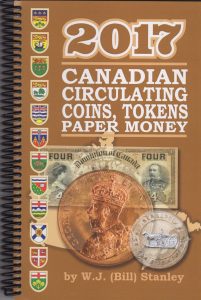 If you are a collector of Canadian coins and looking for a standard reference, there is nothing better than The Charlton Standard Catalogue of Canadian Coins. Available in two volumes, the Charlton catalogs would be the Canadian equivalent of the Red Book Professional Edition. Charlton Press also publishes books for the Canadian currency and token collectors. All of the Charlton books are very comprehensive on their respective topic and a must for the Canadian collector.
If you are a collector of Canadian coins and looking for a standard reference, there is nothing better than The Charlton Standard Catalogue of Canadian Coins. Available in two volumes, the Charlton catalogs would be the Canadian equivalent of the Red Book Professional Edition. Charlton Press also publishes books for the Canadian currency and token collectors. All of the Charlton books are very comprehensive on their respective topic and a must for the Canadian collector.
Like the Professional Edition of the Red Book, the Charlton Catalog is not a quick or portable reference. When I am searching through coins at shows or if I am just trying to identify something I had just acquired, I want a quicker reference with some basic prices that does not require me to hunt around the other information I am not interested in at the moment. I think I found the perfect reference for Canadian numismatics.
While searching one of my favorite online coin supply retailers, I came across the 2017 by W.J. (Bill) Stanley. It is published by Canadian Wholesale Supply of Paris, Ontario. Within the book, it does not carry a copyright date and it does not have an International Standard Book Number (ISBN). It can be found at a number of online numismatic stores but not on stores like Amazon that require an ISBN.
But if you are collecting Canadian Coins, Breton Tokens, or Canadian Paper money you should have a copy of this book sitting next to your Charlton Standard Catalog. While the Charlton books are very complete with a lot of information, the pictures are in black and white. All of the coin images in the Stanley book are in color. Although you can guess what the colors are, seeing the color images on varieties and being able to compare them with coins is of great help.
Canadian Coin Section sample pages
-
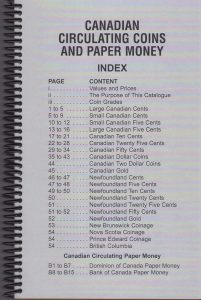
-
Index of the Coin and Currency Section
-

-
Bill Stanley’s purpose of this book
-

-
Sample of the Vicki Cents
-
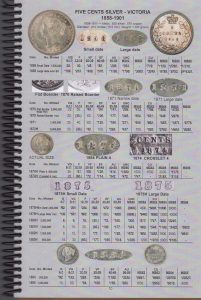
-
Sample page showing how varieties are illustrated
Another advantage of the Stanley book is that it consists only of circulating coinage. Although the Royal Canadian Mint has expanded its catalog of non-circulating legal tender coins over the last decade, if you are just collecting circulating issues, then the other stuff is clutter. It is just the basics of what was circulated in Canada.
This book is divided into three section. The first are circulating Canadian coins, the second for Canadian currency, and final are the tokens. The coin and currency section has a single introduction, guide to reading the tables, and an index to find the particular type you might try to find. The coin section has their pages numbered beginning with page 1 with the introductory parts numbered with Roman numerals. But the currency section begins on page B-1 following page 54 of the coins.
Canadian Currency Section sample pages
-

-
Beginning of the currency section
-
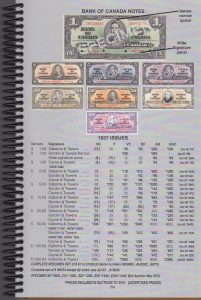
-
A sample page of the currency section
The tokens section appears as if it was a separate book bound with the coin and currency section to make one book. It has a title page followed by a similar introduction, guide to reading the information, and an index. The introductory pages are not numbered but the token listings begin on page T-1.
Breton Tokens Section sample pages
-

-
Title page of the Breton Tokens section
-

-
Index to the Breton Tokens section
-

-
A sample from the Breton Tokens section
-

-
A sample from the Breton Tokens section
If the book was bigger, these page numbering anomalies would be confusing. I only noticed this when I tried to figure out how many pages are in the book. Considering that not every page is numbered and there are some blank pages in the middle, I think there are 132 pages in total. Not very thick and spiral bound for easier handling.
Prices in the book are given for the basic grades and includes prices for significant auctions and prices gathered for rare and significant coins. As most of us are aware, most printed price books are obsolete by the time they are published. What Stanley does is use information he gathers from auctions and coin shows around Canada to determine the prices. In his introduction, Stanley admits he uses his judgment to exclude what appears to be bogus data based on bidding wars or data from untrustworthy sources. He also admits that there may be errors.
Without reaching out to Stanley, it appears he is the sole responsible person for the prices and content of this guide. Maybe that is a good thing considering the inaccuracy of similar guides from other publishers. However, after go through his guide and a number of other sources including the prices from a few Canadian dealers, this book may be more accurate than his caveat suggests.
After that, it is pages of coin listings similar to any price guide you may find. The number of coins minted is included on each line. There are images of coins, images of varieties with an arrow point to subtle differences, and prices in the most relevant grades of circulating coins.
I cannot speak about the Charlton Standard Catalog of Canadian Currency since I do not own that book, but similar to the coins’ section, the Canadian currency section is nothing but the basics. Color images are reproduced from the Bank of Canada and have “SPECIMEN” superimposed on each note. Descriptions note signature, portrait, and serial number differences (i.e., prefix types) for the notes and the prices in the most relevant grades.
Tokens are a very important part of the history of Canadian money. When coins or currency was not available, Canadian towns and provinces created tokens to act in the place of money. The history of Canadian tokens is fascinating and worth another report. It is important to note that the cataloging of tokens is based on the work Pierre Napoleon Breton in his book Illustrated History of Coins and Tokens Related to Canada originally published in 1894, since republished and updated. As part of his cataloging of tokens, he assigned them a number that is now known as Breton Numbers. Stanley lists Canadian tokens by Breton Numbers.
Although I am not a collector of Breton Tokens, I am fascinated by other areas of numismatics especially if they are different. What thrills me about this section is that the tokens are imaged side-by-side with their basic information and prices. It is not a tome on their history but if I was a collector, it would help me identify these tokens and what I might expect to pay for them. I found myself flipping through the pages looking at the tokens, what they say, and thinking about their possible history. I want to go back through my back issues of The CN Journal (publication of the Royal Canadian Numismatic Association) and find some of those stories about tokens I never read.
Flipping the pages of such as basic reference, I never thought I would learn so much. I think it is because all of the other information has been omitted, I can see the coins, images of the varieties, and the prices without distraction. Now that I have learned a number of things, I can pick up other references to learn more.
My only minor nit about this book is the page numbering scheme and the lack of coherent index or table of contents. I give it a grade of MS-68 for being a simple reference of circulating Canadian numismatics and a book that I recommend.
Sep 3, 2013 | books, cents, coins, review
Rosie was not just a riveter during World War II but she also worked at the U.S. Mint in Philadelphia making blanks for coins.
Working in the blanking room at the U.S. Mint was not an easy job. It was hot, loud, and Rosie was confused. Even though she was supposed to feed a sheet of zinc coated steel into the blanking press, Rosie fed a sheet of copper. With the press of a button, 40 copper blanks were made.
Rosie panicked. The president ordered that the U.S. Mint not use the copper for coins so it could be used for the war effort. Not knowing what to do, Rosie let the coins proceed to the next stations where they were washed and “pinched” to create rims keeping her fingers crossed that nobody found out.
The copper blanks were fed into the press along with the zinc-coated steel blanks and thus was born Penny, a 1943 copper cent.
The Wishful Penny is the story of Penny’s adventure from her accidental birth, to an ice cream shop, across the Atlantic, back again, and how one wish made on Penny comes true.
Written for readers in grades 3-5 with a story that can be appreciated by younger students, The Wishful Penny written by J.J. (Jennifer Jo) Young, co-founder of the publisher See the Wish, surrounds the story of a wish made on a penny as it is thrown into a fountain with factual information about the coin and conditions. The story opens with the book’s Rosie, a name obviously chosen, who never worked before but was thrown into working at the U.S. Mint in Philadelphia because the men were off at war. It mentions that President Roosevelt order that copper be preserved for the war effort and even approaches the angst of the time with relative off at war and businesses hoping for survival in difficult times.
The use of factual information makes the story more appealing. Forget the fact that I am some-number-of-many-years beyond the target age group for this book, it has the ability to not only teach the students but also the teachers who may have not thought about using coins as a teaching tool. If a teacher wants to use this book for classroom instruction, the authors offer a teacher’s kit that includes books, worksheets, discussion questions, activities, history tie-ins, and script with a CD of music to allow the students to perform the book as a play.
Aside from the history, the book teaches about real world perseverance from the perspective of Penny, whose optimism about carrying her wish is a good lesson for all children. While having optimism is good, the book also teaches how there is a long road to fulfilling goals that comes with the bumpy road of life. As someone who grew up with parents who wanted me to skin my knees because learning not to was as important as losing the game in order to understand life is just not handed to you, the book portrays that as a series of disappointments. With optimism in tact, Penny goes from the fountain where she meets the silver coins, to Ireland where she lives in a safe with other coins, to running away from thieves, and helping catch them before being mailed back to the United States and finding that a coin is different from the stamps that make the journey with her.
If you buy the book individually, it will come with a CD with 12 songs interspersed with acted audio scenes from the book. It is not exactly faithful to the dialog in the book, but your youngster may not mind. Remember, that the music is intended for your children and that an adult may request their child listen with headphones. After growing up with Peter, Paul and Mary, I am not sure I would have ever like the music. Since I am not the target audience I am not going to complain! However, the audio CD could be just the thing to keep your child busy for an hour during a long drive.
You can also buy the book as an audio CD. The audio book is read by January M. Akselrad, the other co-founder of See the Wish. Ms. Akselrad reads the book just like you would expect to a younger audience. However, I found myself re-reading the book along with her thinking that this might be good for a student who may have a difficult time reading to follow along while listening to the book being read for them.
Although I am not a teacher, I can see using the audio CD with the books in order to show visual highlights of story but the history it shows. Since I was not provided the teaching materials, I can only hope the authors provide teachers with this information.
Coins can teach us a lot about history and history can teach us a lot about ourselves. Although the exact reason for the existence of the copper 1943 cents can only be speculated, turning it into a story for children works on so many levels. I even like that the person who found Penny only to realize she was special was a girl learning about collecting coins. Add to that the collector who buys the coin was a woman is also a lesson that this should not be a male-dominated hobby!
I did not know what to expect when I agreed to review this book. But I was surprised how engaging it was even for a “vintage” person like me. Even though Penny ends up at less than an Mint State (MS) grade by the end of the book, I grade this book MS68 with a recommendation that if your young reader does have reading difficulties also purchase the audio CD. In fact, you may want to consider purchasing the teacher’s kit and donate it to your child’s school. Or for the classes looking to put on a play, why not consider the full-length musical with recorded music. It has to be a great idea for teachers needing new material!
POST SCRIPT FOR PARENTS: After your child reads the book and she wants more information about coins and collecting, let them vista the U.S. Mint h.i.p. pocket change website. “H.I.P.” stands for History In your Pocket, which best describes how many of us see coins.
POST SCRIPT FOR TEACHERS: After your class read this book and performs the play, I would recommend teachers visit the U.S. Mint teacher’s website for additional resources to using coins in the classroom. Who knows, maybe we can turn you and your students into numismatists!
Disclaimer
A copy of the book and audio CD was provided by the author in exchange for this review. Even as I type this, the author does not know what I will say. However, I did inform her I will be donating the audio CD to the county library to be placed in an area where the children need the most help.
Apology
I want to take this opportunity to apologize to the author for taking so long to do this review. She was prompt in sending the book and I should have made the time to reward her promptness with a timely review. I appreciate her patience.
Sep 1, 2013 | ANA, books, charity, coins, education, personal, review
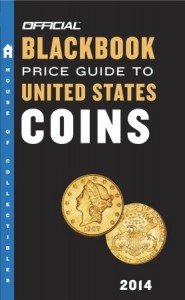 Last year I reviewed The Official 2013 Blackbook Price Guide to United States Coins I received as an e-book from the publisher. In that review I was surprised as to the quality information that was in the book including articles that were written by numismatists sharing their expertise with the collecting public. Unfortunately, some of the information seemed dated and needed updating. Apparently the editors agreed and worked to update information.
Last year I reviewed The Official 2013 Blackbook Price Guide to United States Coins I received as an e-book from the publisher. In that review I was surprised as to the quality information that was in the book including articles that were written by numismatists sharing their expertise with the collecting public. Unfortunately, some of the information seemed dated and needed updating. Apparently the editors agreed and worked to update information.
Based on the review, the editors turned to a numismatist whose experience with computers, the Internet, and writing for the collector who could add the information about using technology to enhance the collecting experience.
This is where your favorite blogger enters the picture.
The Official 2014 Blackbook Price Guide to United States Coins has an new chapter, “Using Technology to Enhance Your Collecting Experience.” Written in plain language for the collector, the chapter discusses what numismatic-related resources are online.
 The chapter opens with a brief history of how computers and the Internet has advanced my collecting experiences. This includes a brief history of the Internet from its birth as ARPAnet through the invention of the birth of the World Wide Web and the services we now take for granted. I wrote it so that when you hear something Internet and web history in the news you have the background to understand why it is important.
The chapter opens with a brief history of how computers and the Internet has advanced my collecting experiences. This includes a brief history of the Internet from its birth as ARPAnet through the invention of the birth of the World Wide Web and the services we now take for granted. I wrote it so that when you hear something Internet and web history in the news you have the background to understand why it is important.
Following the introduction are sections that helps you find the information you want online. These sections are titled:
- Online Price Guides
- News and Blogs
- Mobile Computing
- E-books
- Social Media
- Buying and Selling Online
- Auctions (Established auction houses and their online options)
- Looking into the Future
- Your Security Online
If nothing else, the section “Your Security Online” may be worth the price of the book. It is something I have written in many forms, in many places, and have lectured about locally. These are general awareness tips that everyone should follow.
To their credit, the editors Mark Hudgeons, Tom Hudgeons Jr., and Tom Hudgeons Sr. read my review and updated the 52nd Edition of The Blackbook to address many of my concerns outside of my chapter. It is a better reference than in the past and worthy of a place in your numismatic library!
Autographs For Education
After autographing my first copy of the book I decided that rather than give away my autograph I want to use it to help raise money for numismatic education. For every autograph, I am asking for a minimum donation of $25 to the American Numismatic Association Florence Schook School of Numismatics to be used to further all numismatic education.
You can either mail the check yourself to the ANA and show me that you donated or give me the check and I will mail all of them together. Checks given to me should be made payable to the “American Numismatic Association” (NOT ME!) with a note on the memo line saying “For The Florence Schook School of Numismatics.”
For your donation, I will autograph the first page of my article above the title and give you recognition here on the blog. Since the ANA is a not-for-profit organization, your donations are tax deductible to maximum allowed by law.
One way to find out where I will be is to follow me here on the blog since I usually announce when I am going to a show. For planning purposes, I will attend the Virginia Numismatic Association Show on Saturday, September 28; the Pennsylvania Association of Numismatists show during October 24-26 (my attendance dates TBD) in Monroeville (a suburb of Pittsburgh); and the Whitman Baltimore Expo on Saturday, November 9. I might attend the Wall Street Coin, Currency and Collectibles Show in October if I can resolve a scheduling conflict.
Of course scheduling conflicts do arise, but let me know you if you will be looking for me at a show.
Post Script
Collectors of paper money, world coins, and stamps will be happy to know that the chapter will be adopted for the Blackbook covering those areas in 2015. I will also update the the current chapter since the online world has changed a little since it was written (e.g., Google shutdown the Reader service).
Book cover image courtesy of Random House.
Mar 12, 2013 | books, coins, Red Book, review, values
Merriam-Webster’s online dictionary defines almanac as “a usually annual publication containing statistical, tabular, and general information.” Almanacs have been around for a while in various forms from the earliest times of writing to today. Early almanacs were simply calendars of coming events and records of past events. They included holidays, phases of the moon, and significant dates that related to the weather for the farming community.
Although there have been many almanacs that bridged into the modern era, none had been as famous as Poor Richard’s Almanack written by Benjamin Franklin writing under the pseudonym Richard Saunders. Franklin published Poor Richard’s Alamanck from 1733-1758. Amongst the surviving almanacs include The Old Farmer’s Almanac that has been published continuously since 1792, the Farmer’s Almanac that has been published continuously since 1818, and The World Almanac and Book of Facts published since 1868. These are the almanacs that all others are judged against.
 Having grown up with The World Almanac, reading the Central Intelligence Agency’s The World Fact Book, and being a begrudging fan of the Coin World Almanac, I was interested when Whitman Publishing sent out a notice that they just released the First Edition of the Almanac of United States Coins.
Having grown up with The World Almanac, reading the Central Intelligence Agency’s The World Fact Book, and being a begrudging fan of the Coin World Almanac, I was interested when Whitman Publishing sent out a notice that they just released the First Edition of the Almanac of United States Coins.
Although I read the description, I did not read it carefully because when I opened the package sent to me by Whitman, I found a skinny trade paperback-sized book. I reread the Whitman press release and it said the book was 192 pages. Initially, I felt disappointed in my hopes that there would be a competitor on the market to the Coin World Almanac since competition makes everyone better. So I can get over my initial reaction, I put the book down for a while to overcome my initial reaction to give the book a fair review.
After two weeks, I find I cannot hide my disappointment especially when I place the book next to the Coin World Almanac. Now in its eighth edition, the Coin World Almanac is 688 pages of numismatic reference that is a worthy comparison to any almanac in any industry. The problem with the Coin World Almanac is that it is updated every ten years. Having purchased the last two, the seventh edition seemed stale by 2004. I suspect the eighth edition will begin to feel stale by the end of this year if not by mid-2014. Maybe Coin World should consider shortening their update cycle.
Coin World does not have to worry about competition from Whitman. For as much as Whitman has invested in creating content across their “Official Red Book Series” from the many great authors, their Almanac of United States Coins is so lacking in content that it is many years away from being able to compete.
The only complement I can offer Whitman for this book is that many of the coin images are superb. I do like the images showing the relative grading of the individual series but wish it was expanded to include a few more grades. One example that would help collectors is that the difference between a VF-20 and MS-65 Walking Liberty half dollar is so vast, that having at least two intermediate grades (e.g., EF-40 and AU-50) would be helpful.

Whitman’s Almanac v. Coin World’s Almanac: In this case, size matters!
Whitman is going to have to learn that every numismatic reference book does not have to be a price guide. If they want to include type set-like guides, then do not make it look like a major component of the book. Otherwise, I would recommend people read A Guide Book of United States Type Coins instead. Thus the first improvement I would make is either eliminate the price guide information or find a way to minimize it as a central focus of each section. After all, an almanac is supposed to be about the content and the fact. Price guides are opinions that change with market forces that changes from the end of the editorial cycle until the book is published.
I know Whitman wants to sell books and has to find a way to make this book unique over their other offerings so they do not cannibalize sales, but they have to consider that they may never sell some of these books to certain people anyway. And if Whitman drops the pricing information, that still leaves their other books as an option for the reader. After all, Whitman can include a line at the end of each coin’s section that if they want in-depth information, the read can “consult” Whitman’s other book on the coin.
It is interesting how Whitman included a list of the authors for all of their books as credits but did not print the name of the editor of this book. However, Whitman’s press release named publisher Dennis Tucker as the editor.
Now that Whitman has disappointed me, they need to look at the content they have already invested in with their current books. They can start by taking whatever information is in the Red Book (A Guide Book of United States Coins), the Red Book Professional Edition, and the Blue Book (Handbook of United States Coins) and bring the content together to improve the current almanac. Just doing this would greatly improve this book. Then, it is a matter of an editor either convincing Whitman’s other authors to build on the chapters or distill the information in their other books to something suitable for an almanac.
I really wanted to like this book to the point that I put it aside in order to see if I could get over my first impression. Instead, I started to read another Whitman book that deserves the good review I will write in the near future. But I could not get over the disappointment. The text has no depth, facts that should be in an almanac are missing, and it seems like a glorified coin type price guide. Maybe they should market this as something for the very beginner, even for someone under the age of 12. Therefore I give this book a grade of F-12. The only factor that prevents this book from grading lower are the images. It is not a book I can recommend.
DISCLOSURE: Whitman Publishing provided the copy of the book I reviewed. I will not add this book to the library. It will be donated to my coin club’s annual charity auction in December with the proceeds going to the local Boys and Girls Club.
Cover image courtesy of Whitman Publishing.
Feb 9, 2013 | auction, exonumia, history, review

Front Cover of the Heritage Platinum Night Sports Auction
Opening the Priority Mail envelope delivered in February 4 was a beautiful holographic image of iconic image of the 1980 United States Men’s Olympic Hockey Team celebrating their victory over the Soviet Red Army team. The eye-popping three-dimensional image is far more impressive than the image that appeared on the front cover of Sports Illustrated because of the visual texture it delivers.
The “Miracle on Ice” 1980 U.S. Olympic Hockey Team may have been a bunch of guys trying to play hockey, but to the rest of us, they were a proxy in the Cold War. With the games being played in Lake Placid, New York, the nation gathered around television sets across the nation to hope and watch our boys beat the Soviets—just because they were the Soviets, long suspected of cheating by twisting the rules to pay players at a time when the Olympics were an all-amateur competition. I remember a group of us transplanted New Yorkers watching hockey in the dorms at the University of Georgia trying to teach the southerners about hockey was almost as entertaining as the games.
After staring at the cover you tilt it and the image of Mike Eruzione’s jersey can be seen. Eruzione’s “Miracle on Ice”, game worn gold medal game jersey, and other memorabilia from the 1980 gold medal winning hockey team is what Heritage picked as the highlight of the auction. Current bid for “The Miracle on Ice” jersey is $325,000.
Turn the cover over and there is a three-dimensional holographic image of Lou Gehrig and Babe Ruth sitting on a bench, hats in hand holding a baseball bat. The image is from the 1927 Murders Row team. Tilt the cover to see the 1927-1928 game worn Gehrig uniform jersey that is part of the auction.
Inside the catalog are some of the most phenomenal sports collectibles that could ever be imagined from nearly every sport. One of the more unusual items if “The Bloody Sock” worn by Curt Schilling during the second game of the 2004 World Series. Schilling’s performance on bad tendons have been compared with the fictional Roy Hobbs in the 1984 movie The Natural. It also represents the end of the 84-year Curse of the Bambino. Starting bid is $25,000.
Heritage also has a ticket stub from the 1962 Philadelphia Warriors Wilt Chamberlain 100 Point Game on March 2, 1962 at the Hershey Sports Arena in Hershey, Pennsylvania. Officially, the attendance was 4,124 (or 10 million as the legend grew!). This PSA authenticated ticket is currently at $3,000.
For those looking for a numismatic tie to this auction, you might want to consider:
Since this is not specifically a numismatic item, I am grading it as a specimen release. I am grading this SP69 deducting a point for the typos that should have been caught in the editing process—one being in an item title that could not be ignored. It is a fantastic item and should be on the shelf of anyone who has an interest in sports and sports collectibles.
Happy bidding!
-

-
Front Cover of the Heritage Platinum Night Sports Auction
-

-
Front Cover of the Heritage Platinum Night Sports Auction tilted to show Eruzione jersey
-
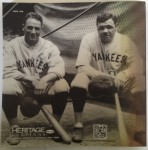
-
Back Cover of the Heritage Platinum Night Sports Auction
-
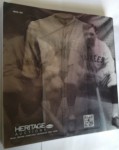
-
Back Cover of the Heritage Platinum Night Sports Auction tilted to show Gehrig jersey
Catalog image is from the author whose catalog is not for sale!
Oct 12, 2012 | bullion, Federal Reserve, gold, history, review
Prior to the very entertaining Vice Presidential Debate, the National Geographic Channel aired a show titled “America’s Money Vault” that was part of their “Behind the Scenes” week. The show was hosted by Jake Ward, editor-in-chief of Popular Science magazine.
The show is centered around the Federal Reserve and primarily the operations of the Federal Reserve Bank of New York. After opening the show at Times Square, we are transported downtown to the New York Fed where they are accepting a deposit of over 1 ton of gold. Following an explanation that the New York Fed is the most trusted handler of gold in the world and has 25-percent of the world’s gold on deposit, we watch the transfer process.
As part of the transfer process, the cameras are brought into the vault and the viewers are show “walls” of gold bars. Unlike the images in the 1995 movie Die Hard: With a Vengeance, it appears that the vault that is more solid than the jail-like bars shown in the movie.
Ward visited with Federal Reserve Chairman Ben Bernanke to talk about the Fed’s roll in the markets. While in Washington Ward visits the Bureau of Engraving and Printing to show some of the process in currency printing. There was also a discussion with the United States Secret Service about anti-counterfeiting.
One of the more interesting visuals was when Ward visited the East Rutherford Operations Center (EROC), one of the New York Fed’s currency operations. Viewers were shown rows of currency and coins being stored on shelves throughout the building. And in a scene to warm my technical heart, the robotic inventory system was profiled.
According to NatGeo TV, the next time America’s Money Vault will air is on Thursday, October 18, 2012 at 4:00 PM Eastern Time. If you will be away at that time, it is worth setting the DVR (or VCR for those still going old school) to record this show.
 This past weekend, the Newman Numismatic Portal (NNP) sponsored the NNP Symposium. For three days, NNP used Zoom to facilitate 38 sessions about different aspects of numismatics. The topics covered everything from U.S. and foreign numismatics to discussions about the industry. The Numismatic Bibliomania Society held its Annual Meeting via Zoom, and Matt Dinger & Mike Nottelmann did a live version of The Coin Show. After listening to them for a while, I now see what they look like — I do not know if that is a good or bad thing.
This past weekend, the Newman Numismatic Portal (NNP) sponsored the NNP Symposium. For three days, NNP used Zoom to facilitate 38 sessions about different aspects of numismatics. The topics covered everything from U.S. and foreign numismatics to discussions about the industry. The Numismatic Bibliomania Society held its Annual Meeting via Zoom, and Matt Dinger & Mike Nottelmann did a live version of The Coin Show. After listening to them for a while, I now see what they look like — I do not know if that is a good or bad thing. 

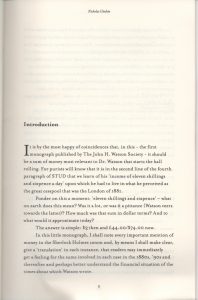

 Did you hear? Coin World started a
Did you hear? Coin World started a 












 Having grown up with
Having grown up with 





